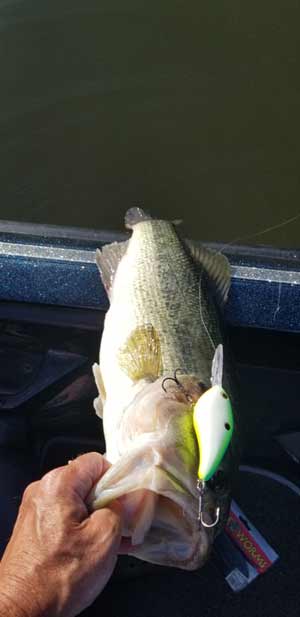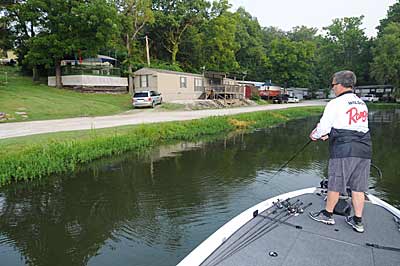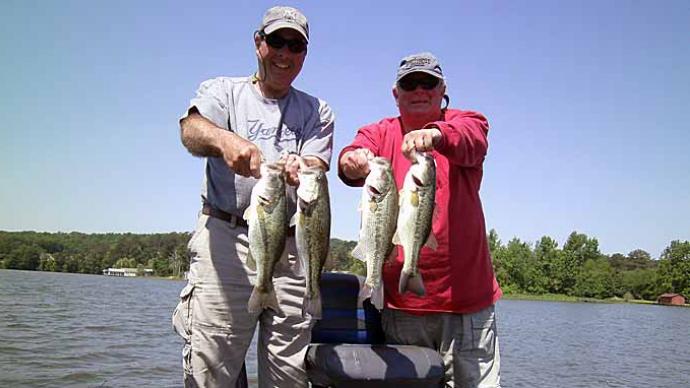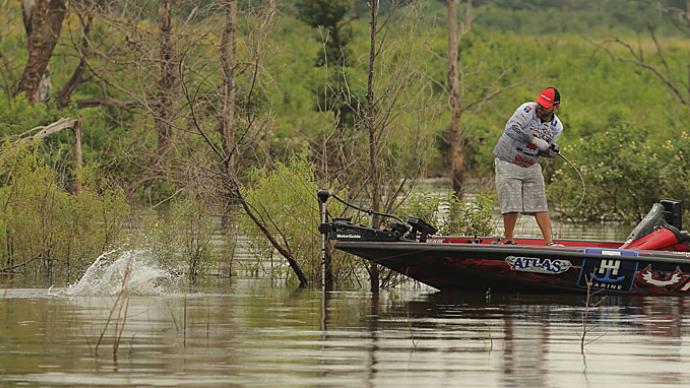
Steve Wilson has a game plan for catching bass from reservoirs controlled by two dams.
The Missouri guide knows current plays a crucial role in catching reservoir bass during the summer when dams release water for power generation or to drop high lake levels caused by excessive spring rains. Wilson’s home fishery of Lake of the Ozarks is a prime example of how dams can affect summertime bass fishing on reservoirs. He describes the lake as “one big river system,” with Truman Dam releasing water into the upper end of Lake of the Ozarks and Bagnell Dam discharging water from the lower end of the lake into the Osage River.
“When Truman releases the water, it fills the lake up at the upper portion of Lake of the Ozarks, and you get a tilted lake,” Wilson says. “It is high up there, and then all that water starts coming down the lake. Then that is when they start releasing water out of Bagnell Dam. It completely dictates the fishing, especially around Bagnell Dam (the lower end). The fish there will turn completely off until there is some generation, and then all of a sudden, they are biters.”
Wilson has also seen how water flow from the releases of dams on the Tennessee Valley Authority (TVA) reservoirs affects the bass fishing on those lakes even more so than in his home waters. “If you don’t have generation there, you might as well not be fishing,” he says.
The veteran tournament competitor believes the current created by the dam releases triggers a chain reaction by delivering more nutrients down the lake’s main channel. “That flushes through across the (main channel) structure, and the baitfish get on the structure to eat the nutrients like the zooplankton and stuff like that, and the bass follow them and eat the baitfish,” Wilson says. “So the current starts the whole food chain and revolves around that current. It is a manmade change that bass adapt to and use to their advantage.”
Wilson’s game plan for fishing dam releases involves strategies for the following situations.
Double dam releases
When the upper and lower dams on a reservoir are both releasing water, Wilson prefers fishing from the mid-lake area to the lower end because the current will be sweeping across the main lake structure. He avoids the upper end because the water is too high, and bass tend to scatter in the newly flooded cover along the bank.
Wilson keys on main channel structure such as points, humps, channel drops along bluff ledges, and rock slides on bluffs to catch bass on the lower half of the lake during maximum flow. Bass will position facing into the current, so Wilson favors fishing structure that receives the strongest current on the main channel. During heavy flow on the lower end, vast schools of bass congregate on the main channel structure, where Wilson and his clients catch numerous bass in the 2- to 4-pound range.
The guide notices the heavy water flow prompts the main channel bass on the lower half to move shallower. “Usually where the current is going the hardest is where bass are the shallowest (5 to 8 feet deep) on top of the structure,” Wilson says. “Usually, when the current goes slack, those bass will slide deeper off that break or suspend off the top of the break.”
A deep-diving crankbait is Wilson’s top choice for catching bass on a lake's middle and lower end during heavy current. “It is hard to beat a deep-diving crankbait then,” Wilson says. “I can cover so much water with it, and I can also hit a fish straight up in the face, which means that the fish has a chance of running from it or biting it.”
Wilson's second choice for heavy flow periods is a 1/2- or 3/4-ounce football jig with a Netbait Paca Chunk trailer. The jig allows him to drag the lure along the bottom or hop it high off the bottom to catch bass in the current.
One dam flow
Wilson prefers fishing up the lake when the upper dam stops releasing water. “What you want there is like an outgoing tide with the water falling,” Wilson says. “That is when the fishing up there gets good.”

The dropping water level on the upper end of the lake reduces shallow cover for bass, so the fish tend to bunch up in any cover still available to them. Wilson finds these bass around shallow docks and laydowns where he flips or skips a 1/2-ounce Trophy Bass Company Pro Jig and a Netbait Paca Craw trailer. He will also skip a bladed jig under shallow docks and throw a topwater frog or buzz bait around any shallow weeds.
Wilson will also fish within 10 miles of the lower dam when it is still releasing water, but the upper dam has shut off the water. He notices on his home waters that the current will be slower on the lower end, causing bass to move off the rocky structure. He looks for bass then in any brush piles on the main channel or inside the coves.
If the upper dam is running water and the lower dam is not releasing water, Wilson stays down the lake and moves into the backs of large coves and creeks, where he flips and skips his jig or bladed jig to shallow docks. The most productive coves and creeks will have baitfish in the shallows.
Zero flow
Both dams shutting off flow prompts Wilson to seek shallow bass, “When they are not running any current, the oxygen levels get so low in the lake that fish do two things: they go really deep or super shallow,” he says. Wilson relies on his jig to catch bass around docks in water 3 feet deep or less. He prefers fishing the back of a creek with water flowing into the lake and an expansive shallow flat.




